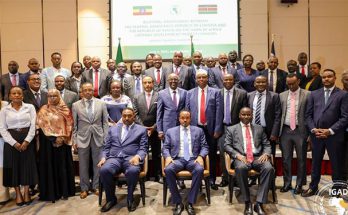 US sanctions on Russia, recently signed – grudgingly – into law by US President Donald Trump, represent an opportunity for additional North African supplies to European gas markets. While much of the discussion has focused on the potential for greater US LNG imports into Europe, the main beneficiary is likely to be North Africa.
US sanctions on Russia, recently signed – grudgingly – into law by US President Donald Trump, represent an opportunity for additional North African supplies to European gas markets. While much of the discussion has focused on the potential for greater US LNG imports into Europe, the main beneficiary is likely to be North Africa.
Whether the gas producers of the Maghreb will be able to cash in on this opportunity is another question.
Russia seems set to continue dominating European supplies but there is a clear opening for incremental opportunities for North African suppliers.
Sanctions
Efforts to rein in Russia come amid speculation over Kremlin interference in the 2016 US election and its ties with those close to the US presidency. Whatever the truth of these allegations, it is clear that relations between the two countries are in a particularly bleak spot.
In the run up to the sanctions, Russia said it would limit US embassy workers – this being the largest such reduction since 1917.
Trump signed the “Countering America’s adversaries through sanctions act” on August 2. In addition to Russia, the law provides for new sanctions on Iran and North Korea.
The statement from the president on the act expressed concern about the way it “improperly encroaches on executive power, disadvantages American companies, and hurts the interests of our European allies”. While the bill had been improved, he said, it remained “seriously flawed”, largely on the grounds of the limits it puts on the president pursuing foreign policy.
The act gives the president the authority to impose sanctions on companies involved in Russian pipeline projects.
“I built a truly great company worth many billions of dollars. That is a big part of the reason I was elected. As President, I can make far better deals with foreign countries than Congress,” Trump said. He went on to describe the act as unconstitutional.
European Commission President Jean-Claude Juncker welcomed the softening of the bill, saying Europe had been ready “to react adequately”. He went on to note the US Congress had said it would only apply sanctions after consulting with allies. However, Juncker said he retained the right to respond should European companies working with Russia in the energy sector be disadvantaged.
Energy concerns were clearly at the forefront of Juncker’s statement, saying US sanctions could also have the effect of threatening energy supplies to the EU.
At the heart of this question of European energy security is the proposed 1,200-km Nord Stream 2 pipeline, following the earlier Nord Stream link, which carried 43.8 bcm of gas in 2016, at around 80% of capacity. The EU and the US took opposing views on Nord Stream 2. The EU said this link would help provide energy security for Europe, the US found exactly the opposite.
Energy security
Concerns over Europe’s reliance on Russian gas are deep-rooted, with some speculation that Gazprom, the country’s monopoly gas exporter, works in concert with Moscow in order to pursue foreign policy goals.
Evidence of US attempts to squeeze Russia came in late July, when ExxonMobil was fined US$2 million for reaching a deal with Rosneft, which was signed by Igor Sechin – who is on the list of previously sanctioned individuals. The US company is contesting the claim.
The ExxonMobil-Rosneft deal was signed in 2014, when Rex Tillerson was the CEO of the US super-major. Tillerson is now the US Secretary of State.
Therefore while Trump may have managed to take some of the sting out of the sanctions, various parts of the US administration, such as the Treasury’s Office of Foreign Assets Control (OFAC), appear to be taking a much harsher line.
While US companies may be able to strike deals with Russian companies, the ExxonMobil fine makes clear how complicated this will be if sanctioned company officials are unable to sign. This will also reduce the amount of potential foreign investment from the US into Russia.
The number of US operators that might be interested in such an arrangement is slim at the moment, given the short-cycle returns of domestic shale resources. The greater impact will be on service companies, which are struggling to shore up returns at a time when they are being squeezed from all angles, and financial institutions that could provide support to complex, multi-region projects.
In terms of the EU’s energy security, much has been made of additional LNG supplies. This sector has benefited from new supplies, from former regasification terminals in the US that have been retooled for export, and the rise of flexible import capacity from floating storage and regasification units (FSRUs).
The US administration has made it a foreign policy goal to support the export of LNG, particularly to offtakers in Eastern Europe. Poland received a first cargo of US LNG in June, with the country emphasising its interest in moving away from Russian gas.
Germany’s Wintershall published the results of a poll in late July, reporting opposition from German citizens to US sanctions on Russia. Wintershall, which has agreed to provide the funds for 10% of Nord Stream 2’s costs and describes Russia as its most important core region, went on to add that its poll showed opposition to US LNG imports.
Poland and other Eastern European countries will benefit from new LNG import infrastructure as it diversifies their supply mix – and gives them a better negotiating hand in future talks with Gazprom. While US LNG may be able to provide some supplies to the EU, it is clear that pipeline gas will continue to be a cheaper option.
Maghreb
Algeria has struggled in recent years to attract investment, with exploration declining as a result. Despite this, some major gas fields are due to start up in the near term and production is expected to increase this year.
The US$3 billion Reggane Nord project should reach 2.9 bcm of production at plateau, while Touat should reach 4.5 bcm, Timimoun 1.6 bcm and Isarene 3.6 bcm. These projects were due to start up in 2016-17 but 2018 is more plausible.
Algeria has lost market share and volume in Europe since a peak in 2005, according to an Oxford Institute for Energy Studies (OIES) paper from 2016 by Ali Aissaoui. The paper noted the loss of ground in the Italian market by Sonatrach as “particularly severe”, with Algerian flows losing out to Russian supplies.
Rising domestic production, coupled with investments in solar energy and improved terms to attract foreign bidders, should do much to bolster Algeria’s case in Europe – particularly if Russian interests lose competitiveness.
The other potential North African supplier is Egypt. Cairo has recently set out a desire to become gas independent in 2018, as domestic production increases. Such a move should allow it to curb LNG imports and possibly even return to LNG exports.
Egypt has a number of projects starting up, most notably the major Zohr field, which is due to begin production by the end of this year. There are hurdles along the way – domestic demand is likely to increase and existing fields will decline – but there is the chance of exports into Europe. The easiest solution would be to export LNG from its two existing plants, Damietta and Idku, but there has been some discussion of an ambitious pipeline, which would involve Israel and Cyprus.
North Africa’s population is rising and its demand for economic improvement is growing. Governments face challenges about how to navigate this, while also securing export volumes.
The EU and the US are keen for further diversity of European supply, which increases the appeal of North African gas exports. Opposition to Russia will go some way to bolstering the Maghreb’s attraction but international financial organisations also have a role to play – as can be seen by the European Bank for Reconstruction and Development’s (EBRD) decision to provide funding for gas projects in Tunisia, for example.



